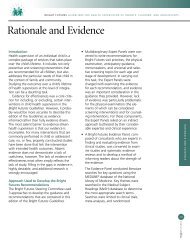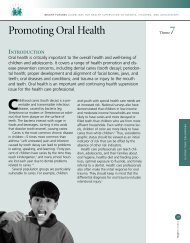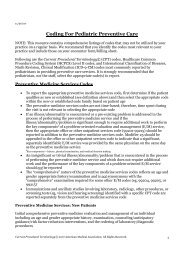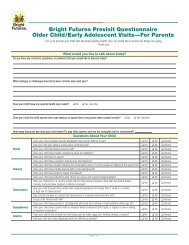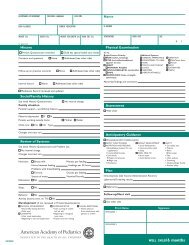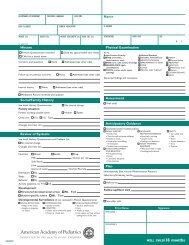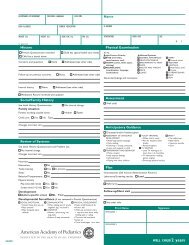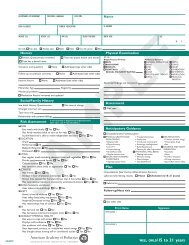POCKET GUIDE - Bright Futures - American Academy of Pediatrics
POCKET GUIDE - Bright Futures - American Academy of Pediatrics
POCKET GUIDE - Bright Futures - American Academy of Pediatrics
Create successful ePaper yourself
Turn your PDF publications into a flip-book with our unique Google optimized e-Paper software.
Adolescence<br />
50<br />
<strong>Bright</strong> FUTURES<br />
■ screen females ages 12 to 21 with known risk factors for<br />
iron-deficiency anemia (extensive menstrual or other<br />
blood loss, low iron intake, previous diagnosis <strong>of</strong> iron-<br />
deficiency anemia) annually. For those with no known<br />
risk factors, screen every 5 to 10 years during routine<br />
physical examinations. (CDC)<br />
■ screen males ages 12 to 18 during their peak growth<br />
period during routine physical examinations. (AAP)<br />
■ screen males ages 12 to 18 with known risk factors<br />
for iron-deficiency anemia (low iron intake, special<br />
health care needs, previous diagnosis <strong>of</strong> iron-deficiency<br />
anemia). (CDC)<br />
oral health<br />
■ Determine whether the adolescent has regular dental visits.<br />
■ Assess eating behaviors (frequency <strong>of</strong> consuming foods<br />
and beverages high in sugar) to determine the adolescent’s<br />
risk for dental caries (tooth decay).<br />
physical Activity<br />
■ Determine how much physical activity the adolescent<br />
engages in weekly. Compare the adolescent’s physical<br />
fitness level with national standards (school’s standardized<br />
physical fitness assessment).<br />
■ Determine how much time the adolescent spends watching<br />
television and on other media activities (computer, video<br />
games). Determine whether the adolescent watches television<br />
during mealtimes.<br />
Anticipatory Guidance<br />
discuss with adolescent, Parents, or both<br />
growth and physical Development<br />
■ how the adolescent compares with others on the standard<br />
growth chart.<br />
■ upcoming physical changes and specific concerns.<br />
■ For females, normal accumulation <strong>of</strong> fat in hips, thighs,<br />
and buttocks. (Fat accumulation ranges from 15%–18%<br />
<strong>of</strong> body weight before puberty to 20%–25% at the end<br />
<strong>of</strong> puberty.)<br />
■ For males, a slight weight gain before a growth spurt<br />
(between ages 9 and 13), a decrease in body fat during<br />
the growth spurt, and an increase in body fat after puberty<br />
(by age 18, about 15%–18% <strong>of</strong> body weight).<br />
■ For late-maturing males, ages 15 to 17, reassurance that<br />
their growth is normal. (use charts that plot height velocity<br />
by age and sMr to ease concerns.)





